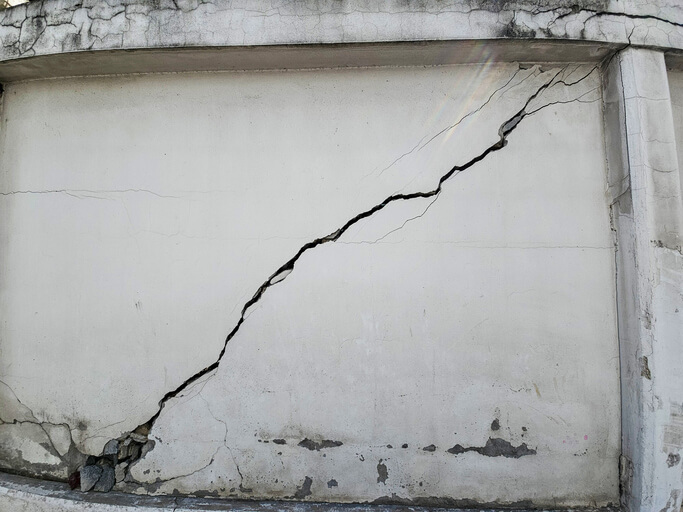What is Structural Wall Repair? Causes, Signs and Solutions

Structural wall repair is essential to keeping your commercial or industrial building safe, strong, and aligned with SEL and SUL targets. Cracks, moisture damage, and shifting walls may seem minor, but they could signal deeper issues that put your structure (and your tenants) at risk.
If you’ve noticed signs of wall damage, this guide will help you understand what structural wall repair involves, how to spot early warning signs, and what repair options are available for commercial buildings.
What Is Structural Wall Repair?
Structural wall repair refers to the process of identifying and correcting damage that weakens load-bearing or exterior walls. These repairs restore a building’s strength, stability, and safety.
Unlike simple cosmetic fixes, structural wall repair targets deeper problems like:
- Seismic damage
- Moisture buildup and roof condensation
- Foundation movement or settling
- Rusted rebar or spalling concrete
- Aging materials or poor original construction
Depending on the severity of the damage, repairs can involve anything from surface sealing to full structural reinforcement or wall reconstruction.
Why Structural Wall Repair Matters
When you’re responsible for a commercial or industrial property, wall damage isn’t something you can ignore. Structural wall repair helps you:
- Protect occupants and valuable assets
- Preserve long-term property value
- Avoid legal or financial liability
- Stay compliant with building and safety codes
Even minor-looking cracks or water damage can escalate over time. Proactive repair saves time, money, and stress down the road.
Signs You May Need Structural Wall Repair
Many signs of damage are easy to overlook—until they become a major repair. Watch for these red flags that could indicate the need for structural wall repair:
- Horizontal or stair-step cracks in concrete or masonry
- Walls that bulge or bow outward
- Cracks wider than 1/8 inch, especially near windows or doors
- Rust stains or chipping concrete (spalling)
- Water damage, mold, or musty odors
- Doors and windows that stick or won’t close properly
If you’re seeing any of these, it’s time to bring in a structural expert. Early intervention is key to avoiding more serious (and more expensive) damage.
A Note on Seismic Risk and Older Buildings
If your building was constructed before 1997, it may not meet modern structural safety standards. In these cases, wall damage may point to deeper issues that warrant a more comprehensive seismic retrofit.
4 Types of Structural Wall Repairs
Structural wall repair varies depending on the wall’s materials and the severity of the damage. Common techniques include:
1. Epoxy Injections
For narrow cracks in concrete walls, high-strength epoxy is injected to fill the gap and bond the material, restoring its original strength.
2. Rebar Replacement and Concrete Patching
When corrosion causes rebar to expand and crack the surrounding concrete, the rebar is exposed, treated, or replaced, and the concrete is patched with high-strength repair mortar.
3. Structural Reinforcement
In cases of advanced damage, structural engineers may recommend adding steel support plates, doweling in new rebar, or rebuilding sections of the wall to stabilize the structure.
4. Moisture Mitigation
If water or condensation caused the damage, structural wall repair may include sealing leaks, improving insulation, or adjusting ventilation to prevent future moisture buildup.
Hiring the Right Repair Contractor
Not every contractor is equipped to handle structural wall repair, especially in large-scale commercial or industrial buildings where the work can affect multiple systems, tenants, and operations.
The right team doesn’t just “get the job done”—they help you avoid costly delays, code issues, and unnecessary disruptions.
Here’s what to look for:
- Proven structural experience. Choose a licensed contractor with a strong track record in seismic retrofitting and structural repairs, not just cosmetic or residential work.
- Commercial job site familiarity. Commercial buildings come with more complexity. Your contractor should understand how to work around tenants, equipment, and daily operations without causing major disruption.
- Engineer collaboration. Structural wall repair often requires close coordination with structural engineers. Look for a team that’s comfortable reviewing plans, submitting RFIs, and adapting to field conditions.
- Portfolio and references. Ask for documentation of similar projects, including before-and-after photos, scope of work, and client testimonials. This gives you insight into their capabilities and process.
- Clear communication. A good contractor will walk you through the findings, repair plan, and potential risks—without upselling or leaving you guessing.
A qualified contractor will deliver safe, efficient results—and give you confidence every step of the way.
Saunders Seismic: Trusted Support for Structural Wall Repair
Not every crack calls for alarm, but when it does, it helps to have a trusted partner by your side. Whether you’re investigating early signs of damage or planning a larger repair, our team is here to support you.
At Saunders Seismic, we bring decades of hands-on experience and a practical, people-first approach to every project. Our in-house crews, collaborative process, and honest guidance make structural wall repairs clearer and more manageable, whether you choose to work with us or not.
You don’t need to know exactly what the problem is—that’s what we’re here for. Whether it’s early signs of wall damage or a long-overdue repair, we’ll give you straightforward answers and practical solutions that work.
Let’s talk about what your building needs. Contact us today to schedule a no-pressure consultation or explore our full range of structural repair services.
